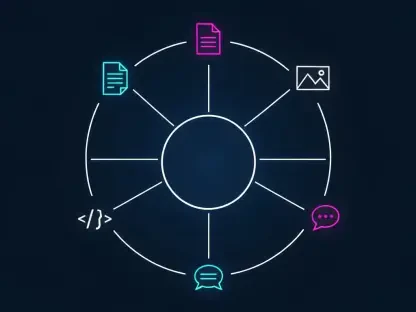Artificial Intelligence, particularly innovations like Anthropic’s Claude, is rapidly transforming the software development industry. This evolution is particularly evident in the programming labor market, reshaping job roles and economic impacts tracked by tools such as the Anthropic Economic Index. As AI continues to develop more advanced capabilities, especially in contexts like coding, it fundamentally changes how software is developed and maintained. These innovations bring new efficiencies and challenges, leading to a landscape where automation and augmentation coexist, influencing roles ranging from frontend development to extensive backend infrastructures.
Understanding Automation vs. Augmentation
Automation and augmentation represent two different paradigms in AI’s role within software development. Anthropic’s Claude Code exemplifies the shift towards automation, handling 79% of coding tasks autonomously. This contrasts with traditional AI models that still rely significantly on user input and collaboration, marked at 49% interaction in earlier models like Claude.ai. This trend towards automation suggests a future where machines take over more routine tasks, granting developers the capacity to focus on complex challenges. The increased prevalence of coding-focused AI agents could lead to significant shifts, not just in how tasks are completed but also in the skillsets required by developers. This evolution presents a dual narrative, where the excitement of enhanced capabilities meets concerns over potential reductions in coding roles, creating a balanced ecosystem between AI and human effort.
The move from augmented collaboration to increased automation addresses efficiency and precision but requires new ways of thinking about software development processes. As systems like Claude Code increasingly perform tasks without human intervention, there’s a parallel need for robust validation systems and improved understanding of AI’s decision-making pathways. The challenge lies in maximizing the benefits of this technology while addressing implications for workforce dynamics and career trajectories. As developers adapt to these changes, balancing automation and augmentation could become crucial, ensuring human insight remains central in critical stages of project development.
Frontend Development Revolutionized by AI
AI’s profound impact is perhaps most noticeable in frontend development, where dynamic interfaces and user experience elements are crucial. Developers now harness AI like Claude to craft user interfaces and interactive components for web and mobile applications efficiently. This shift places languages such as JavaScript, TypeScript, HTML, and CSS at the forefront, signaling an evolution in contemporary software development. As AI becomes capable of handling many frontend tasks, roles in this domain might face substantial transformation, with traditional coding practices being overturned by AI-driven methodologies.
The revolution in frontend development underlines a significant shift in the technological focus. While backend operations traditionally anchor software functionalities, user perception increasingly values sleek, interactive frontend interfaces. AI’s proficiency in generating responsive and aesthetically appealing designs means frontend developers must adapt, leveraging AI to enhance rather than replace their capabilities. Concerns about AI’s potential to disrupt require active adaptation and skill enhancement, shifting the focus from task execution to innovation in user-centric design. As AI tools grow more sophisticated, human creativity and intuition remain vital in defining and refining user experiences, encouraging developers to redefine their roles within this dynamic environment.
Early Adopters vs. Enterprises: The Adoption Gap
Startups have emerged as frontrunners in adopting AI technologies like Claude Code, illustrating their agility and readiness to embrace innovation. Agile startups harness these advancements to gain a strategic edge, accelerating their developmental cycles and bolstering competitive advantages. By contrast, larger enterprises often proceed more cautiously, hampered by intricate security protocols and risk-averse integration practices. The disparity in adoption highlights a broader trend across industries where smaller entities capitalize on emerging technologies more swiftly, positioning themselves ahead of established competitors.
This adoption gap has implications not just in competitive dynamics but also in the overall landscape of digital innovation. The swift implementation of AI in startups stems from their need to be agile and resource-efficient—qualities that prove advantageous in leveraging the full potential of AI. However, the slower approach typical of larger enterprises reflects a calculated consideration of AI capabilities and cybersecurity needs. The need to balance innovation with stability often sees these organizations adopting AI at a more measured pace, which could potentially leave them lagging behind more nimble rivals in tech proficiency and customer engagement. As this trend persists, the need for collaboration and knowledge sharing between these disparate groups grows more essential, ensuring that varied approaches to AI integration benefit the industry as a whole.
Beyond Business: AI Integration in Learning
The integration of AI extends well beyond traditional business environments, penetrating educational sectors and personal development spaces. Students, hobbyists, and academics have increasingly turned to AI-driven tools for learning and experimentation in coding, significantly contributing to the overall interaction with AI platforms. This widespread usage indicates that AI has become an instrumental part of educational processes and self-guided learning, facilitating a deeper understanding of technology among general users. The accessibility and effectiveness of AI coding tools democratize knowledge, making sophisticated programming capabilities available to a broader audience beyond professional environments.
This trend emphasizes a shift in how coding is perceived and learned, equipping a new generation of tech enthusiasts with sophisticated tools right from the start. As AI systems deliver intuitive interfaces and step-by-step guidance, individuals gain the ability to experiment and iterate rapidly, enhancing both learning experiences and the quality of personal projects. This inclusion fosters a culture of experimentation and innovation, allowing non-professionals to contribute meaningfully to the tech ecosystem. As AI continues to redefine what is possible in coding, educational institutions and informal learning environments are likely to evolve, integrating AI more deeply into their curriculums and methodologies, ensuring students are well-prepared for the changing landscape of technology-driven industries.
Evolving Developer Roles in an AI Era
The rising tide of automation reshapes the roles of developers in today’s AI-driven environment, prompting a transition towards tasks centered on design and user experience. As AI systems increasingly handle routine components like component creation and styling, developers are required to focus on more strategic and high-level tasks, such as conceptualizing project objectives and optimizing user interfaces. The advent of so-called “vibe coding,” a practice where developers articulate goals in natural language, allows AI systems to manage implementation effectively and challenges traditional notions of direct coding involvement.
This shift heralds a transformative period for software professionals, necessitating shifts in both mindset and skillset. As AI becomes more proficient at routine tasks, developers must enhance their creative and strategic thinking capabilities, translating user-focused visions into tangible outcomes. This evolution not only modernizes the practitioner’s role but also fosters an emphasis on collaboration between humans and machines, optimizing the strengths of both in the software development process. The interplay between human intuition and machine efficiency encourages a holistic approach to project realization, underscoring the ongoing importance of human input in a technology-centric era.
The Dynamics of Feedback Loop Interactions
Despite the advancements in AI, human validation remains a crucial component through feedback loops in AI-assisted coding. These loops, where human input refines AI-generated output, ensure that AI works harmoniously with human expectations and intentions. While AI is proficient in executing technical aspects of code development, collaboration through these loops sustains quality control and nuanced decision-making. Human oversight preserves accountability, allowing developers to validate, amend, and enhance AI contributions, guaranteeing alignment with evolving project goals.
As AI models develop further, there is continuous discussion about the longevity and necessity of feedback loops. While they are indispensable at present, future expectations and technological advancements raise questions about their permanence in the development cycle. If AI capabilities advance to levels where these loops become less essential, the balance of power in software creation may shift even further toward machine autonomy. Developers and platforms must remain vigilant about these shifts, ensuring that proven safeguards and quality assurance measures remain intact. Monitoring these dynamics will provide valuable insights into optimizing human-AI collaboration, fostering improved workflows while securing robust and efficient development processes.
AI’s Impact on Research and Development Cycles
The efficiency brought about by AI will likely have a ripple effect on research and development, furthering AI’s own progression. AI’s capacity to expedite coding tasks translates into accelerated development cycles, offering more time and resources for innovation and experimentation. This self-reinforcing cycle denotes a significant potential for breakthroughs across various technological horizons, as AI enhancements in coding can significantly optimize research workflows, bolster productivity, and spur advancements.
The ability of AI technology to streamline development processes positions it as an essential driver of innovation. As AI continues to evolve, its integration into research and development processes could hasten the pace of discoveries and applications. Improved resource allocation and reduced mundane tasks provide researchers and developers with opportunities to push boundaries in their respective fields. The cumulative impact may lead to an acceleration of technological evolution, bolstering growth, innovation, and collaboration across domains. Concurrently, such outcomes necessitate an ongoing evaluation mechanism, ensuring that these advances are harnessed responsibly, ethically, and to their fullest potential within tech ecosystems.
Opportunities for Collaboration in AI Research
Anthropic’s invitation for economists and data scientists to collaborate opens doors to increasingly refined insights into AI’s labor market effects. Collaborative research initiatives aim to explore the nuanced transformations AI introduces, providing a more comprehensive understanding of workforce dynamics, economic shifts, and industry evolution. The convergence of diverse expertise enriches current knowledge, laying the groundwork for future explorations into AI’s socio-economic ramifications.
This call for collaboration signifies an important strategy to bridge gaps in existing research, offering a platform where diverse insights can converge to decode AI’s complex impacts. It recognizes the value of multidisciplinary approaches in devising strategies that guide adaptations within the digital economy. By fostering an environment of shared learning and cross-sectoral partnerships, these collaborations provide a treasure trove of data, knowledge, and expertise, aiding stakeholders in navigating shifting landscapes with clarity and confidence. This proactive approach underscores a commitment to informed decision-making, ensuring that AI integration considers broader implications and aligns with sustainable technological, societal, and economic development goals.
Evaluating Limitations and Future Research Directions
An objective assessment of AI’s current applications must account for inherent limitations in understanding AI-generated code’s ultimate use and quality. Dataset constraints and the tendency towards early adopter biases can skew perceptions of AI’s efficacy and scalability. To accurately predict AI’s long-term impacts, a broadened research scope is vital, encompassing varying industries and contexts, enhancing visibility into AI’s broad influence on job roles and economic activities.
These challenges highlight a significant need for expanded research to expose AI’s full potential and limitations, guiding transitions within software careers. Insights drawn from comprehensive data analysis, sector-specific case studies, and cross-disciplinary research collaborations emphasize how AI shapes evolving landscapes. Through robust and exploratory research endeavors, researchers can provide industry stakeholders with actionable knowledge, aiding developers and companies in making informed decisions. Ultimately, a deeper understanding of these dynamics equips organizations to navigate complexities associated with AI integration, ensuring sustainable, inclusive, and adaptable future development pathways.
Navigating Transition Periods in Software Careers
As AI capabilities evolve, developers face a landscape where adapting to streamlined, AI-centric workflows becomes paramount. Professional transitions necessitate strategic adaptation to emerging industry standards, underscoring the importance of training, skill enhancement, and support systems in ensuring career sustainability. Guidance tailored to these transitional phases allows professionals to embrace adaptive practices, aligning with an AI-enhanced workforce while leveraging their unique human input to retain a competitive edge.
Strategies aimed at facilitating smoother career transitions emphasize continuous learning, essential for navigating an AI-reshaped software landscape. By equipping developers with resources, mentorship, and educational programs focused on burgeoning AI trends, the industry can maintain a skilled, agile workforce capable of adapting to rapidly changing technological environments. Structured support during transitional periods fosters resilience, enabling developers to capitalize on AI-driven shifts and technological advancements, securing their roles in an increasingly AI-centered paradigm. Ensuring comprehensive professional development pathways aligns with a commitment to fostering talent, cultivating innovation, and maintaining robust and sustainable software industry standards.
Economics Observed Through the Anthropic Economic Index
Anthropic’s Economic Index provides a unique lens to examine and understand software sector transformations brought on by AI technologies. This index tracks relevant economic shifts linked to AI adoption, offering insights into the evolving dynamics between technical advancements and economic outcomes. Unveiling these patterns aids in deciphering the relationship between AI innovations and economic growth, informing strategic, policy, and operational decisions across industries.
By capturing complex economic changes triggered by AI adoption, the Anthropic Economic Index assists stakeholders in evaluating both micro and macroeconomic implications within the software development sector. This forward-thinking tool illuminates emerging trends, offering a comprehensive understanding of how technological proliferation influences economic parameters. The index’s insights empower organizations, policymakers, and thought leaders to make data-driven choices, preparing them to harness AI’s capabilities effectively while mitigating potential risks. Ultimately, by contextualizing technology-induced changes through economic indices, stakeholders gain essential clarity, enabling informed adaptability to the evolving technological-fueled economy.
AI-Driven Growth and Innovation Opportunities
Artificial Intelligence is making profound strides in reshaping the software development industry, particularly with the advent of innovations like Anthropic’s Claude. This transformation significantly reallocates roles within the programming labor market, and tools such as the Anthropic Economic Index are crucial for understanding these changes. AI’s advanced capabilities are altering the way software is created and maintained, focusing especially on coding. These developments introduce heightened efficiency but also present new challenges, fostering an environment where automation and augmentation are pivotal. This duality affects various job roles throughout the sector, influencing tasks ranging from frontend development to the intricate workings of backend infrastructures.
As AI becomes increasingly sophisticated, it facilitates rapid problem-solving and code generation, streamlining developer workflows. This shift necessitates a reevaluation of traditional development methodologies as automation begins to handle tasks previously requiring human intervention. Hence, individuals in the industry must adapt, acquiring new skills to thrive in an evolving landscape. The advent of AI tools emphasizes collaborative efforts between human developers and machines, enhancing productivity while also transforming the economic dynamics of software development. In essence, AI is not only augmenting human capabilities but also redefining the future of tech innovation.









